#but its post wwii china
Text
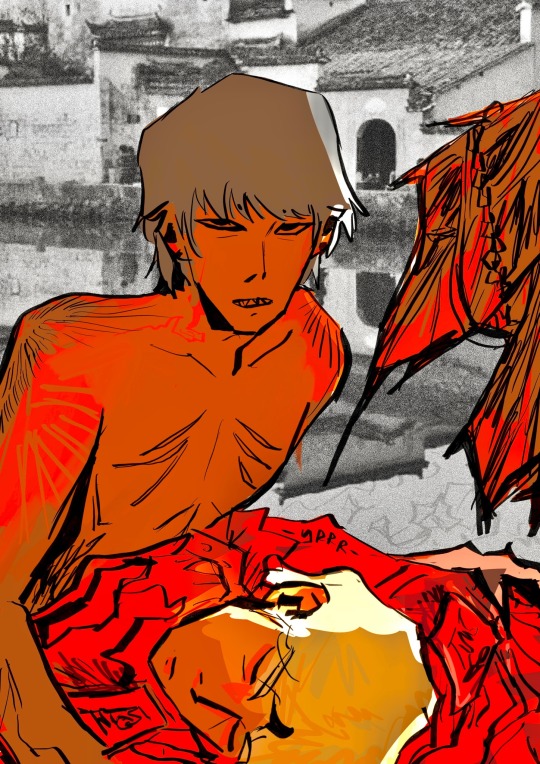
I first saw it when I was heading towards Shanghai to promote the Treaty of Amity and Commerce. It was nibbling on a waterfowl under the steel bridge, gulping it down along with its feathers. I exclaimed loudly, pointing towards the southeast waters. When everyone turned their heads, the area was devoid of anything but a few ripples. A few weeks later I saw it again by the Suzhou River. Crimson tail, and a face which resembled the locals. In broken Chinese, I asked the grandmother living by the river if she had seen a similar creature. She mentioned that there used to be water spirits here, and a child had drowned. I asked other locals as well. The driver I knew from the embassy said it's a merman he saw when he was young. Another playboy said it might be a gimmick of an underground dance hall to attract customers. They would have mermaid performances, with people swimming in glass tanks wearing fish tails. He was from a prestigious local family with insights into such matters. But I knew the mermaid didn't come from there. It didn't seem like something which belongs to this world.
After social gatherings, I often took walks by the Suzhou River and frequently asked for hard bread from restaurant kitchens to feed river fish. Usually, within seconds, the bread would be devoured by the hungry school of fish. But sometimes, it would float there for a while before decomposing. So I knew there must be something underwater deterring the fish. That's when I began to throw more valuable items. Plastic toys, glass bottles, metal pocket watches, and a wooden mermaid sculpture I carved myself. Without exception, they sank into the riverbed, at that place where strange things often occurred.
Later on, I got into a shipwreck on my way back to Shanghai from Guangzhou. I woke up in a public hospital in Shanghai. My assigned doctor was Dr. Chen. He is a sharp and indifferent person who seemed to dislike Westerners, which was understandable. We colonized his homeland and exploited his people.
The nurses form the hospital said that I was found on a shallow in Fengxian. There were a few rotting sea fish and a small bottle of rum the size of a pocket. Back then, I was certain that this creature saved me. But I didn't tell anyone because it sounded too crazy. Whether it truly existed or was just a psychological defense mechanism to alleviate anxiety and fear during the tumultuous 1940s, I couldn't say. Because after that, I never saw it again.
#ANT1PODE#yr’s oc#victor chen#ethan brown#suzhou river 2000#but its post wwii china#oc#interspecies relationships#interspecies love#illustration#ANTIPODE 1947#au: historical#usa ambassador#鲛人#merman#ANTIPODE
10 notes
·
View notes
Text
imo part of contemporary racist attitudes (from any side of the political spectrum tbh) towards east asia are a lineage from older orientalist beliefs that easia (particularly china and japan) is ancient and unchanging. orientalists of the 19th century saw our countries as places that were stuck in time, decaying through inertia and opposition to "progress" (which, of course, would be brought to them by opening themselves to the west).
modern-day east asia... enthusiasts [polite smile] i'd argue cultivate a descendent of that thought. those who don't assume easia is just like their home country instead treat easia like it's insular from history and the rest of the world, as though our countries have not been historically imperialised and are not bombarded (like the rest of the world) with western viewpoints and american mass media. as though we don't go through societal change through our own efforts and of our own accord.
but no - east asia is a holdout against the tide of modernity. culture is not the background and context against which we move, but traits of each individual's character. an unruly child isn't just upset because his parents aren't buying him candy, he is rebelling against confucianism, and his parents disciplining him is bringing him back in line with confucian teachings. we are defined by rules, philosophy, and tradition—the more ancient these things are, the more intriguing for our onlookers.
better yet, to be untouched by modernity is to be untouched by its discourses. you know, "japanese people don't care about political correctness, they just write what they want" and "actual japanese women don't mind being sexually harassed" and "japan is homogenous so you can't possibly expect them to be sensitive towards other races." japan is presented as static and unchanging—people don't care because this is how things always were, and this is how things will be forever. it's their tradition. it's their culture.
meanwhile china's rapid societal modernization post wwii is largely regarded in every aspect to have been brutal and barbaric. whether change yields positive or negative results it's viewed negatively, as though it doesn't matter how many years pass or how many steps are taken, chinese people are still backwards and regressive, always socially lagging behind the west. because that is apparently our culture.
and yes this comes from all sides of the political spectrum. the right-wing fanbase which idealizes the unchanging nature of japan, a "progressive" fanbase that assumes japanese people are so tied to tradition and an imagined culture that everything goes back to rigidity and long-established practices, often justifying harmful things in the name of respecting japanese culture. nothing and no one in china can't be explained by saving face and confucianism, which is at all times oppressive, evil, and a source of mystical guidance for chinese people.
being considerate and acknowledging that you might not immediately understand every cultural nuance is good, acknowledging that not every story needs to be personally relatable is good, acknowledging that people are influenced by cultures different from your own is good. but at some point it becomes ignoring the fact that asians are humans who are influenced by our culture in addition to personal experiences, feelings, traumas, ambitions, politics. like just think about how everyone around you interacts with culture and to what degree that informs their actual personality and deepest desires and assume that asians are the same as you in that respect please.
being an asian among easia "enthusiasts" is like there's always this interminable search for authenticity, for what is "traditional," for the "real" japan untarnished by these modern western ideas of feminism, and meanwhile many societal advancements for china are just... ignored (don't you know regressive china is so homophobic that disney can't even portray gay affection?). everyone wants to pull us back through time and explain us through adherence to culture and tradition, as though the modern day and just... simple human experiences don't matter or contribute to our lives. we just gotta be explained by something else, something that makes us other from the west.
166 notes
·
View notes
Text
It has been quite time since my last post, moving from India to China taken me some effort 💥
But passion has no limits and boundaries, so here he comes “bitter sweet 🍋 ” game changer and of its times auto industry challenger “the Citroën Light 15 1952 Traction Avant 11CL”.
Before WWII 1934 he came with technology the others started to use 2 decade after. Produced 1934 till 1957.
This one, quite rare of 26.500 pieces out of 760.000 total produced volume. With right site steering and UK origin - Slough. Wooden dash and rich chrome, cozy leather was the Britain streets traction throne. Or on the streets of Australia and South Africa shown.
So welcome street master 🍋 to your new home.










45 notes
·
View notes
Note
Do you think Alfred is insecure about being young? Like I know that there’s countries younger or closer to age to Alfred, but the people Alfred hangs out with the most, has more economic ties, and has military alliances with are way older than Alfred (ex literally all of Europe and Asia). So I was wondering if you think Alfred, being always around people with way more experience than him, feels insecure about being so young and ‘inexperienced’ maybe that’s why he wears glasseS
Interesting question! As I see it, yes and no.
Yes—in the 18th century, when he was much younger, and rebelling against Arthur. Going hat in hand to the other Old World empires and nations like Francis and Antonio for money was a pretty intimidating experience. So it was with Gilbert, coming to whip his ass into shape in Valley Forge. Even with other nations where he wasn't asking for major favours to fund his rebellion but more like 'hey recognise me? please? can my ships come to your ports?' like Morocco or Yao, during the Old China Trade (uhhhhh ive been banned from all the usual trading posts all across my father's empire...and I heard you guys like otter pelt and ginseng?).
No, because from the 19th century onwards, he's very much growing into a world power. I see Alfred as being quite a zealous idealist who sees potential for improving the world (not always in the best way, but from his POV it is), and this is the period where his mindset is increasingly one of brazen, youthful self-confidence. To him, his age is an asset. He's casting a pretty jaundiced eye on the Old World as a whole—perceiving them as being full of religious feuds, outdated monarchies and straitjacketed by nonsensical traditions: they’re ossified fucks who ought to realise the glory of republican civilisation and everything else he's got grand ideas about. Like, one contrast is really how much more intimidated I see him being going to China during the Old China Trade in the late 1700s—versus the brazen gunboat diplomacy of the Perry expedition to Japan in 1853. Like, the contrast with how the Americans behaved themselves when they had no navy and their ships were so small the Chinese traders thought they were tenders from larger vessels and not ocean going ships (lmao) and the Perry expedition is huge. 18th century Alfred would’ve been more intimidated around a nation who beheaded Kublai Khan’s emissaries and fought in more battles long before he was born—19th century Alfred isn’t.
And even less so in the 20th century—especially during WWII. There’s no victory unless he puts his thumb on the scale, and even Sir Lord Arthur Kirkland is openly begging for it. If people had any remaining thought of him as the young, ambitious crown prince somewhat walking in the shadow of his father, all that is gone in WWII. He steals the fire of the gods and literally makes it shine brighter than a thousand suns in all its terror and awe. Other nations can get under his skin, especially in the dynamics of a rivalry (Arthur, in their power struggle over influence, Kiku, as a duelling Pacific empire in the late 1800s—1945 and then also Ivan). But older Alfred is far less likely to be insecure solely on account of them being older than him. It’s more if he perceives they’re challenging his dominance and hegemony—or if they’re questioning his idealism and principles. Like Antonio at the end of the Spanish-American War—oh, you really are your father’s son. I can see moments of vulnerability where his youth and inexperience shines through (such as the American Civil War), but older Alfred’s insecurities tend to dig on faultlines regarding: challenges to his hegemony and principles because unlike Lord Father (tm), I think he’s far more of an idealist. He wants to be great and good, but greatness often is in direct conflict with the latter.
#hetalia#hetalia headcanons#hws america#alfred f jones#aph america#long post#i dont really do him with glasses mainly bc I see him as a pilot#during WWII and no lasik then#you'd have to have good vision
162 notes
·
View notes
Text

early decaydance meeting [2005, colourized]

A note:
When I first posted this artwork in May of 2022, I didn't know that the design on the hoodie I chose to draw Pete wearing was a depiction of the Rising Sun flag.
Even though I was aware of the Rising Sun's historical context, I was, unfortunately, not aware enough to recognize it in the hoodie's artwork.
And for that, I'm sorry.
The Rising Sun is a symbol of imperialism and hatred.
It was the flag flown by the Imperial Japanese Army during World War II, as they violently colonized Korea, Taiwan, Manchuria, and numerous other regions of Eastern Asia. The populations of these regions were stripped of their cultures, dehumanized, and massacred. This history is recent. The consequences and impact of these atrocities are still being felt today.
Yet, despite the militarism and genocide the Rising Sun represents to Korea, China, and more, it is still used in Japan. Its recent history is disregarded, due to it having existed for hundreds of years prior to WWII. (It's also used in other countries, like the United States, where the history isn't common knowledge, and it simply "looks cool".)
This article, written by Lauren Oh, offers perspective on the way the symbol's usage in the US continually affects her as a Korean American. To her, it is a constant, painful reminder of how her heritage was damaged, and how millions of people suffered, just because they were Korean. And yet, the flag continues to be printed on T-shirts.
(The Wikipedia for the Rising Sun also delves into the extended history of the symbol, for those looking to find out more.)
It is crucial that we understand that the Rising Sun is deeply offensive.
It is crucial that we recognize it when we see it, that we educate others, as to actively help prevent its usage.
The Rising Sun should be viewed in the same way as the Swastika, or the Confederate flag; it is a hate symbol.
Reblogs have been turned off on the drawing, in an effort to prevent the image from being spread any further. I figured that it would be better to leave it up with this note attached to it, as a lesson, as opposed to trying to erase it entirely.
To my fellow artists, and to bandom in general: please do not make the same mistake as me. Learn to recognize the Rising Sun, and do not represent it in your artwork.
Don't draw Pete in the hoodie. Don't draw Andy in the shirt he was styled in at the VSFS. Don't draw Frank with the elbow tattoo he used to have, because "being accurate" doesn't actually matter. Don't reblog works that has the symbol depicted, reach out and let others know about the history. Be proactive.
Listen to East Asians. If you actively choose not to, even after reading all of this, you are being racist. You are excusing imperialism. You are enabling hatred, even if you think you aren't.
#shut up kell#i am white. if i've said anything incorrectly here please do not hesitate to let me know. thanks.
743 notes
·
View notes
Text
Tucker Carlson out at fox
Don Lemon out at CNN
FOX already blaming Donald Trump for their dominion scandal and it’s spiraling size drawing in Supreme Court Justices
Trump and DeSantis attempting to out-Hitler one another
Courts going to the right
Politicians passing increasingly dangerous laws.
Ukraine attempting to join NATO, as China, who gets most of its oil from Russia, says “post soviet countries (like Ukraine) lack legitimacy in international courts”
India, Israel, and Saudi governments going increasingly right. Fighting in Sudan.
The world is sorting itself into two camps, just as I’d did before WWII.
Watching it implode is comforting insofar as it pleases me to have gotten predictions correct, and no further.
The next 2 years will be some of the most dangerous in the history of the world. Be vigilant. Be kind. Be brave. Be safe.
I am very glad the pandemic happened when it did, because people will know how to shelter.
I am not optimistic. I don’t want to frighten people but I want everyone to be safe.
We have to march and organize and VOTE. That’s the thing that holds it at bay. It’s the only thing that keeps violence from happening—that all peaceful measures are exhausted.
70 notes
·
View notes
Note
Just read that the reason the US boomed post wwii wasn't because of fdr/domestic policy but because the US had little international competition since Europe was destroyed. China closed off etc, soviet union was communist and only the usa had the infrastructure and was in a league of its own and that even if this had continued under reagan and onwards we would still have the inequality and other economic problems we have today. Is this true?
This is a common misconception, confusing an entirely temporary dominance in production with national prosperity. It's wrong on both foreign and domestic levels.
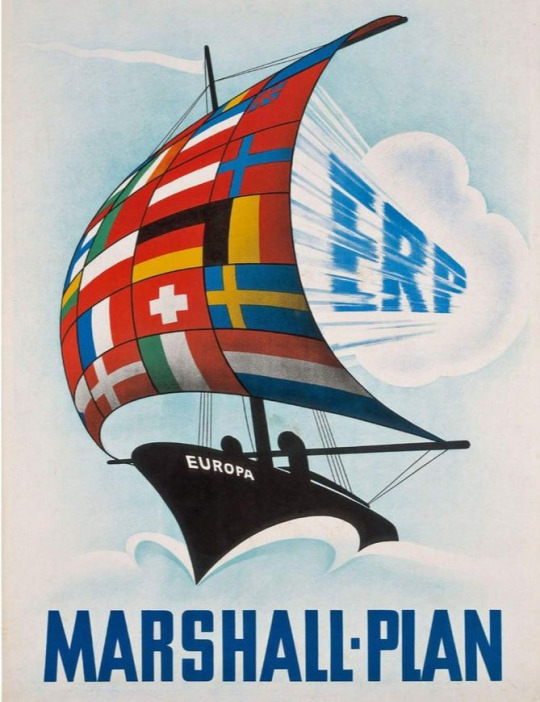
I'll start with the foreign: it is true that the U.S had (relatively) little international competition to start with after WWII, but it was also true that the U.S had (relatively) little international customers either. Europe, formerly the richest region in the world, had been utterly devastated. The Soviet Union and China were out of the question due to Cold War concerns. In Central and South America, Africa, and Asia, trade was limited by lower incomes and the increasing popularity of import-substitution industrial policies.
This is why, after WWII, the United States pursued a policy of fostering international competition and giving these countries access to the U.S' massive domestic market in order to spur economic recovery in Europe and Japan and prevent those countries (and Latin America, Africa, the Middle East, and Asia) from going over to Communism. Hence the Marshall Plan, hence Bretton Woods, hence GATT, the World Bank, the IMF, and on and on. Here, I recommend Judith Stein's Pivotal Decade: How the United States Traded Factories for Finance.

On to the domestic: the main reason why the argument that the U.S economy was prosperous after WWII because of international dominance is stupid is that trade just wasn't that big a part of the U.S economy: U.S exports and imports together were less than 10% of U.S GDP throughout the 1940s (with a brief exception for the war), the 1950s, and the 1960s. The U.S had industrialized behind massive tariff walls in the 19th century, and even after the Underwood Tariff of 1913 that shifted Federal policy from tariffs to income taxes, the economic habits of generations remained.
When it comes to the major sources of post-war economic prosperity, you really do need to look at the New Deal, WWII economic policy - especially bond policy that saw 85 million Americans buy a combined $185 billion in war bonds that would be released into the post-war economy, and the GI Bill which generated $33 billion in home loans (unfortunately, almost entirely for white veterans only).
40 notes
·
View notes
Note
Was the Bolsheviks' failure inevitable as a result of democratic centralism, and authoritarianism and the low value they placed on human life? or could things have gone very differently if Stalin didn't take power? (1000 words pls)
Re: this post on my sideblog
A small nitpick but I try and avoid using the word "authoritarianism" - it has a lot of connotations but isn't sufficiently specific.
Nothing is written in stone until it happens, but I do think the Bolsheviks were doomed, more or less. I don't think the purges were inevitable, but collectivization at a minimum probably was.
The underlying issue that no amount of organizing or ideological purity or state terror or legal reform could change was that the USSR was poor. Russia was poor to start and then it went through WWI and the civil war in short succession and got much poorer.
Communism was supposed to happen in industrialized countries - the German Revolution of 1918 was supposed to leave them a communist state that could use its advanced industrial base to support Russia, its backward cousin.
Instead, the USSR had to try and speedrun the industrial revolution on its own, condensing centuries of bloody capitalist accumulation into a decade and change of even bloodier socialist accumulation. This was not going to be pretty. Everything - all of horrors - can be tied back to this basic fact.
Stalin fucked up the USSR in a lot of ways - he built a cult of personality they never really recovered from, he killed genuine worker participation in the party, and he ordered a shitload of people murdered in a way that warped the country mere years before WWII.
But the USSR was never going to be democratic, in any real sense. Most of the country were peasants! They had few common interests with this party of workers and their ideology of collectivization. They were also doomed - if not by communism, then by capitalism, because peasant classes do not tend to do well under any type of industrialization - but if they had a voice, it would've been against the party.
Maybe the real question is about what came after Stalin and collectivization and industrialization - whether Khrushchev and his successors could've made something more than the stagnant, bureaucratic mediocrity that was the late USSR. Certainly, China seems like they've done a lot better at that than the USSR did, though I leave it to you whether you consider them a success story.
66 notes
·
View notes
Text
Meta Series on "Propaganda Reblogs"
With political tensions re: China reaching a near-unprecedented high, the Chinese state propaganda machine will likely go into overdrive over the next few days, if not until autumn, after it'll be made official whether President Xi will extend his term for another five years.
This means, as turtles, we may expect to see many more "propaganda reblogs" — posts that look like these:

I'm humbly presenting this meta series, which dive a little more into what these posts are about. I confess, I do have an ulterior motive — based on the provided info, I hope I can make a case of why these posts aren't the most suitable for fandom fun, and appeal to fellow fans to please consider refraining from using these posts for joking, for making candies, for making light of them in any way.
Given the length, this meta series is composed of 5 sections:
1) Introduction: why I am, for once, waving my candy-washing soap
2) Anatomy of a propaganda reblog, Part 1: the midnight timestamp
3) Anatomy of a propaganda reblog, Part 2: the ultrashort response
4) Beyond the propaganda: the significance (and tragedy) of events remembered by these posts
5) Conclusion: The Li Jiaqi Paradox
(Below the cut: Part 1: Introduction)
As a fan, I never feel it's my place to tell my fellow fans what they should or shouldn't do. I'm also customarily hesitant about washing candies. Fandom is about having fun, and our corner of fandom, in particular, has always been about imagining, clowning, not taking ourselves too seriously.
It's very nice. A very good thing.
However, given the unique political situation in China, and the fact that Twitter material has, on multiple occasions, been screenshot and imported onto Weibo, I'm appealing to everyone reading this to please consider refraining from playing with these "propaganda reblogs".
This includes joking about them. This includes making candies from them. This includes making light of them in any way.
There are two reasons. One has to do with the nature of the events they address, which I'll touch on later (Section 4). The reason I'd like to focus on first is as follows:
Despite the ubiquitous, "everyone reblogs" nature of these propaganda posts, the ultrashort responses our favorite stars often offer to them, these posts are, by far, the most politically-sensitive material on their blog. The close-to-synchronous timestamps, the similarly-worded responses, are actually the consequences and reflections of the posts' political sensitivity and more importantly, perhaps, of the care the stars and their team have put into them.
Stars in the public eye — particularly, "traffic" stars who garner lots of attention — have little choice but to put in such care: their responses are heavily scrutinized not only by anti-s, but by "melon-eaters", by non-fannish, nationalistic trolls looking for their next famous victim to make an example of.
It's not fun when these stars make a mistake.
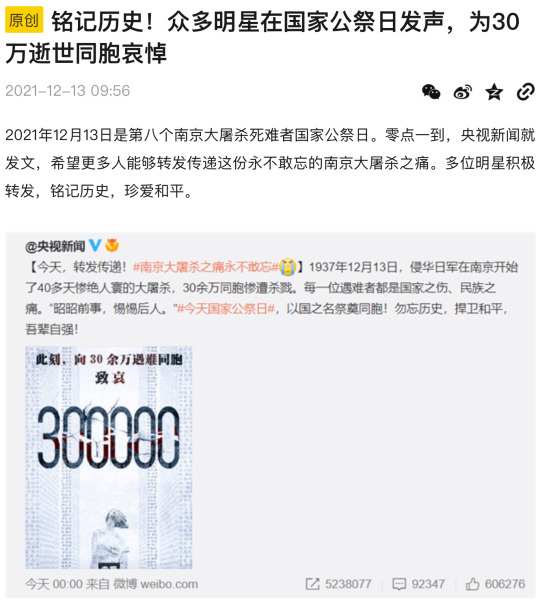
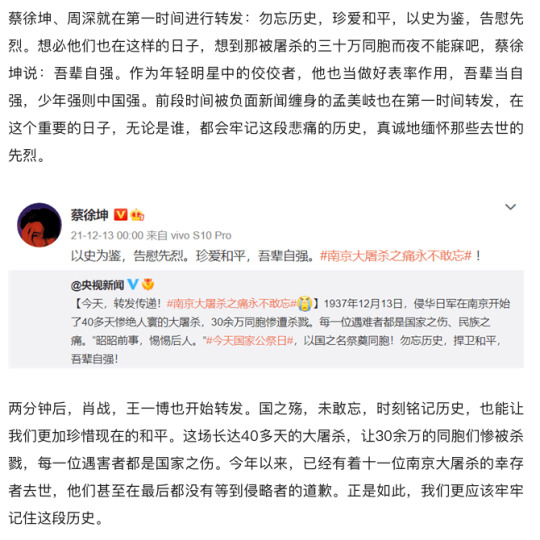

Screenshots from an article on SOHU 搜狐, tallying which star reblogged CCTV's "propaganda post" on the anniversary of the 1937 Nanking Massacre 南京大屠殺, also known as the Rape of Nanking, a brutal mass killing of Chinese by the Imperial Japanese Army during the Second Sino-Japanese War. The article noted the timestamps the reblogs were made, pointing out that Gg and Dd, who reblogged at 00:01 and 00:02 respectively, were behind other stars including Cai Xukun 蔡 徐坤, Zhou Shen 周 深, and Meng Meiqi 孟 美岐, who reblogged at 00:00, the same minute the original post was posted. The Chinese state propaganda has been using Japan's war crimes during World War II to fuel its people's nationalistic sentiments, despite the dissolution of the Empire of Japan in 1945 (and the formation of the modern state of Japan, in which the Emperor only occupies a ceremonial role). Reactions of Chinese public figures to propaganda posts related to Japan and WWII have therefore been heavily scrutinized by nationalistic / bored / mean netizens seeking for the next "traitor" in their midst to judge, to "cancel".
=====
The "Propaganda Reblog" Meta Series:
1) Introduction < YOU'RE HERE
2) The midnight timestamp
3) The ultrashort response
4) Beyond the propaganda
5) Conclusion: The Li Jiaqi Paradox
109 notes
·
View notes
Text
unrelated and I think I'm gonna make this post unrebloggable but I think that knowledge of the Battle of Shanghai in particular is really important for understanding more nationalistic Chinese ppl's feelings about the ROC flag and the way it's mobilized by the west and the taiwan independence movement because like. That flag was literally the flag of all of china from 1912 until 1949, which means it was flown by chinese forces throughout the entirety of WWII. As a result, an incredible amount of emotion is bound up in that flag. Chinese soldiers did suicide bombings on Japanese tanks during the battle of Shanghai under that flag and I think lots of people, even ones that aren't super political if they're older, have some sense of an emotional connection with it as representing an important era in the history of all of china.
so, regardless of the actual merits of a taiwan independence platform to see it then used divorced from any of that context as a symbol of, regardless of whether this viewpoint is true or not, a US-directed plot to destroy Chinese unity, to re-imperialize China and and re-enslave its people, I don't think it's really all that surprising that reactions to that usage get very emotional
9 notes
·
View notes
Note
hi! i've never played an actual smt game (the closest i got was p1+both p2 on psx, though i do plan to eventually!), i saw someone talking about how there are themes of japanese nationalism, even fascism in the series, especially smt4 and raidou. how accurate is this interpretation? if those themes exist, are the writers expecting the player to agree, or are they shown neutrally (negatively?) as a potential aspect of the law-neutral-chaos alignment? if they exist, how is it represented? thanks!
Yes, the nationalism exists. I've covered most of the extreme examples in the past. Most of it is in SMT4 and Apocalypse.
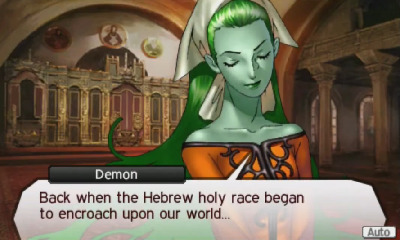
In Identity Crisis Part 3, section four, "Themes of Nationalism and Xenophobia," covers the bizarre "foreign demon" label, the Sinophobia in Ikebukuro with Xi Wangmu that was so unbelievable to some that I created a map (below) to illustrate how they literally segregated Japanese and Chinese demons in this traditional "Chinatown," and the can of worms that is the National Defense Divinities, including Masakado's aggrandizement. Also check section seven and the implications of the Neutral path.
All of this is critical to the game's plotting save Masakado and Neutral.
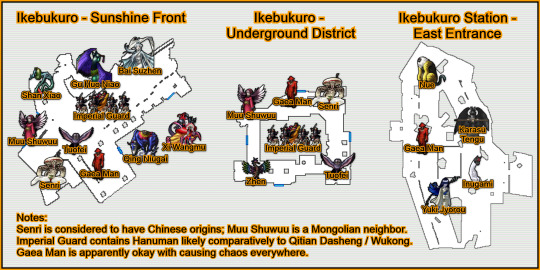
Japanese-Jewish Common Ancestry Theory. What else can I say that hasn't already been said? It forms the backbone of the 4 duology's worldview.
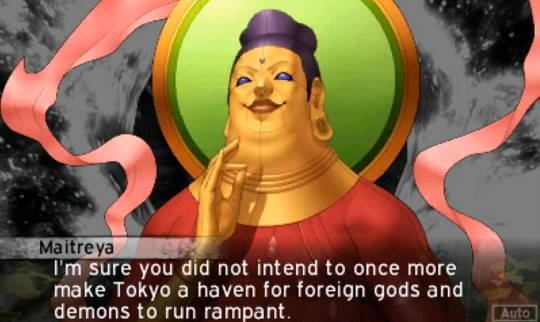
(Pssst, hey Maitreya, you are technically a foreign god to Tokyo.)
The Raidou series starts in 1931, on the cusp of when Imperial Japan invaded China. Though clearly alternate history, the first game contains a chapter that requires you save from a curse someone implied to be the Taisho emperor himself (and if not, it would then have to be Hirohito). And it's worded in beaten-around-the-bush ways like he's "someone important for the future of this country" but that your task is virtuous. So there's little wonder there were issues with Raidou's appearance Nocturne HD in China and Korea.
I should also mention Kazunari Suzuki, a writer for the early games in the series. On his Twitter (baelzebub), he regularly posts or retweets right-wing JP political views, including denying Japanese WWII war crimes like comfort women. It's unknown how long he's held these views or if they impacted his SMT writing, but I think it's safe to assume that maybe he's not a great person.
I don't know if I would call aspects of SMT's writing intentions fascist (treating this separately from potential intentional fascist themes seen in its fictional alignments and scenarios), but the nationalism is definitely there and a lot of it is due to sloppy writing without consideration for its implications. But no doubt there's some serious intent behind other parts, like the SMT4 Ikebukuro scenario.
47 notes
·
View notes
Text
Animation Night 149: Toei
Hi there. It’s Thursday. You know what that means (yes, it means i’m freeeeee)
Today we will be rolling back to some of the earliest days of anime!
The story of Toei goes back to 1946. In the immediate aftermath of WWII, there were very few games in town when it came to Japanese animation (or, to be fair, animation in most places). During the war, animators had been recruited to make propaganda films such as Momotaro: Sacred Sailors, among them Akira Daikuhara.
In the immediate aftermath, Kenzō Masoaka (of Benkei tai Ushiwaka, for anyone who remembers AN24) began the first effort to make an animated film post-war. This film was titled Sakura: Haru no genso (Cherry Blossom: Spring’s Fantasy); it was followed by a series of three films about a cat called Tora-Chan. But Masoaka’s studio struggled, constantly closing and re-opening. At the time it was operating under the name 日本動画映画 Nihon Dōga Eiga or Japan Animated Films, or just the abbreviation 日動映画 Nichidō Eiga. In 1956, they were bought by live action studio Toei (itself approaching 20 years old, founded in 1938) and renamed to Toei Dōga, where they started making increasingly elaborate animated films.

Toei of this era was sometimes called the rather patronising name ‘Disney of the East’. There is some truth to it, in that their ambition, especially in the early years, was certainly to make animated films as elaborate as those of old Walt. Their first feature was 白蛇伝 Hakujaden (1958), based on a Song Dynasty Chinese legend about a lost pet snake who transforms into a woman in the hopes of reuniting with her former owner, a monk who thinks that’s sus, and two pandas who try to sort it all out; in English it’s variously translated as The White Snake Enchantress, Legend of the White Serpent or even Panda and the Magic Serpent.
Part of the goal of the film, to Toei Dōga president Hiroshi Ōkawa, was a gesture of reconciliation towards China after the whole ‘invading and occupying’ thing.
The film was Rintarō’s first animation job; it also left a massive impression on a young Hayao Miyazaki, who wrote the following in Gekkan ehon bessatsu: Animēshon (1979), trans. Beth Cary and Frederik L Schodt in Starting Point:
What I’m saying here is that when young people feel attracted to the heroes of a tragedy [context: such as The Diary of Anne Frank], whether in animation or other media, a type of narcissism is really involved; this attraction they feel is a surrogate emotion for something they have lost.
From personal experience, I can say that I first fell in love with animation when I saw Hakujaden, the animated feature produced by Toei Animation in 1958. I can still remember the pangs of emotion I felt at the sight of the incredibly beautiful, young female character Bai-Niang, and how I went to see the film over and over as a result. It was like being in love, and Bai-Niang became a surrogate girlfriend for me at a time when I had none.
It is in this sense that I think we can achieve a type of satisfaction, by substituting something for the unfulfilled portion of our lives.
The feelings evoked by Bai-Niang may go some way to explaining the role of similar girls in Miyazaki’s movies...
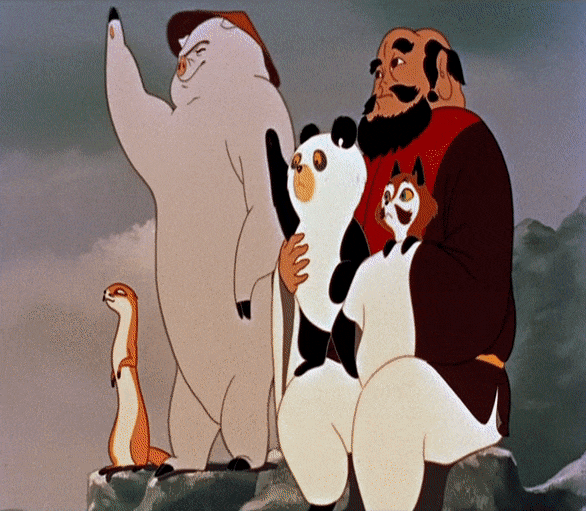
Hakujaden has some curious properties as a work of animation. It was, especially for the time, astonishingly elaborate and straining the technical capabilities of the industry (although the claim on Wikipedia that it had 13,590 staff seems rather dubious lmao). The drawing count is stratospheric thanks most scenes being animated on ones and twos - the opposite of the limited animation techniques that anime would later perfect. Despite that, it is also the work of an inexperienced team, and compared to later works its animation can feel awkwardly timed, the flood of inbetweens turning everything to mush.
Nevertheless, there are two stars of the show in terms of animation. One is Yasuji Mori, who would later be one of Toei’s star animators, creating scenes such as the dance at the beginning of this post - as well as teaching Miyazaki after he joined Toei. The other is Akira Daikuhara, who was way ahead of the game on effects animation, creating the film’s transformation sequences. Daikuhara would go on to be one of Toei’s main animators of human characters, while Mori tended to take the animal/mascots; he has been a relatively forgotten figure, although that’s starting to change with articles like these ones by Matteo Watzky, whose research just digs deeper and deeper.

Toei’s early films tend to follow the precedent set in Hakujaden, adapting folktales from (mostly) China and Japan. In 1959 they covered a Japanese story in Shōnen Sarutobi Sasuke; 1960, they took on Saiyūki (Journey to the West); then Anju to Zushiōmaru (The Orphan Brother, 1961) and Arabian Nights: The Adventures of Sinbad (1962).
In this period of Toei, there was a lot of ambition, and also a feeling of inadequacy compared to the elaborate animated films being made in other countries. Hayao Miyazaki, who joined Toei in the 1963, wrote in 1982:
I used to create feature-length works for Toei Animation, but compared to the works just mentioned, they were obviously far inferior, at least technically. Sort of like showing rabbits slipping and falling, that sort of thing. We wondered if we would ever catch up to the level of what was being done in America, France or Russia, or if it were even possible to do so. Frankly, we really didn’t know.
To begin with, we didn’t even know what we had to do to reach the same level of excellent as the best works out there. We knew we had constraints, such as short production schedules, small budgets and so forth, but above and beyond that, we began to develop an inferiority complex: we wondered if we even had the basic talent needed to proceed. In retrospect, the only thing that probably kept us going, and drove us to pursue such a long-term goal, was our determination.
Miyazaki’s words should be taken with a grain of salt, since they definitely suit his personal myth-making. Still, conditions at Toei in the 60s were rough, leading to the first major unionisation struggle of anime history, which I wrote about in AN70. The studio started bringing on part-timers paid hourly rather than a salary, and created severe pay discrepancies, which were met with strikes and departures from the studio. Saiyūki took such a tole on its director Taiji Yabushita that he was hospitalised; Yasuji Mori would later create the term ‘anime syndrome’ for this sort of overwork because it was not the last time by any means.
However, I’m going to zoom over all of these to get to the わんぱく王子の大蛇退治 Wanpaku Ōji no Orochi Taiji (The Naughty Prince’s Orōchi Slaying, more commonly translated The Little Prince and the Eight-Headed Dragon) in 1963 - not because it’s necessarily more important, although it’s remembered as one Toei’s best films, but because I happen to have a fantastic analysis of one of its key scenes on hand thanks to AniObsesive and Toadette.
youtube
Wanpaku Ōji breaks from precedent in many ways, particularly its visual design, which takes on highly simplified shapes reminiscent of the then ultra-modern UPA style by way of haniwa figures. The story at least follows the pattern, adapting a Shinto myth in which the storm god Susanoo battles (guess what) an eight-headed dragon Yamat no Orochi. Susanoo is motivated by the death of his mother Izanami, and goes on a journey to try to find her, which leads him to the village of Princess Kushinada - a village with a dragon problem, which they’ve kept at bay only by sacrificing Kushinada’s seven sisters. Susanoo, horny for a princess who looks like his mum, decides it’s time to intervene.
The dance scene above comes in the middle of the movie, in which the goddess Ame-no-Uzume performs an increasingly mystical dance. It was an ambitious experiment of Makoto Nagasawa, who had joined as an inbetweener on Saiyūki, with large spacing and broad motion to create a snappy feeling. Animation Obsessive writes:
Typical motion at Toei, Nagasawa said, would be “neatly in-betweened from the first [key] pose to the last [key] pose.” In other words, in-betweens smoothed out the movement and made it longer, more complete and more realistic. By contrast, Nagasawa’s drawings of Uzume are often at wide intervals, with minimal in-betweens. Sometimes, she basically teleports from one frame to the next.
Even when the intervals aren’t that wide, the way Uzume moves remains big, broad, clear and non-real. Nagasawa pushes her gestures, increases her speed, shows us only what he wants to show us. The action is crisp, always holding its abstract shape. No naturalistic touches distract from the core form of what Uzume does.
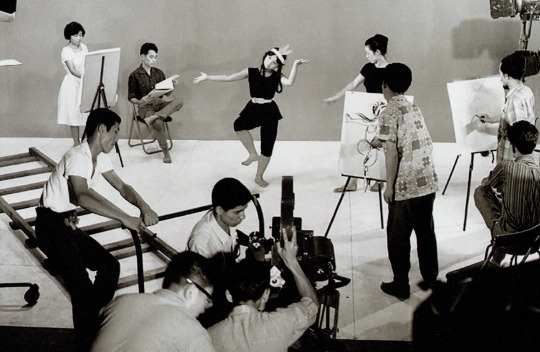
Alongside Nagasawa, Yasuji Mori was now coming into a role close to that of the now-standard 作画監督 sakuga kantoku aka sakkan or animation director, an experienced artist whose job is to correct the drawings from many different key animators to keep them on-model. Modern anime productions tend to have a strictly hierarchical approach where the characters are designed by one or a few character designers, usually also the lead sakkan. At Toei, things had been a bit more fluid - the individual animators would often design the characters they were going to animate, with a division of labour closer to the old Disney style. On this film, it became more of a hybrid: Mori drew the final model sheets, but the animators would submit suggested designs to him.
For the most elaborate scenes, such as the dance, they went to great lengths to record a suitable score and record live-action footage with professional ballet dancers. I encourage you to read the AniObsessive article for the details.
At the time of Wanpaku Ōji, Toei was starting to face competition. The already-renowned mangaka Osamu Tezuka had founded MushiPro, which was rapidly taking over TV, and the sphere of TMS satellite studios were starting to get going and siphon away many of their best people such as Yasuo Ōtsuka. Still, the animators at Toei were determined to try and stand alongside international animators:
The team was well aware of the trends in world animation at that time. According to Nagasawa, they were watching work from Canada (Norman McLaren), Czechoslovakia (Jiří Trnka), Russia (The Snow Queen), France (The King and the Mockingbird) and so on. It was all bold, new animation. In The Little Prince, Toei took up the challenge this work presented, without simply copying it. The team contributed to modern animation while staying rooted in the ancient, and in Japan itself.
Subsequently, Japanese animation is sometimes divided into a ‘Toei tradition’ vs. a ‘MushiPro tradition’, of full vs limited animation respectively, followed by the various successors such as Ghibli on the one hand and Madhouse on the other. As ever this is not really very accurate, and both ‘lineages’ crossed over extensively (just look at Kanada).
Toei’s own output adapted to the times. Takahata’s Horus: Prince of the Sun (AN 70) might be the last of the ambitious movies in their old style; after this, the fairytale films were gradually replaced by gekiga animation such as Tiger Mask, super robots like Mazinger Z, and then at the end of the 70s increasingly science fiction adaptations of Leiji Matsumoto’s works (AN 146). In the 80s, shōnen exploded onto the scene and Toei made a lot of Dragon Ball and Saint Seiya, later joined by other franchises like PreCure, Digimon and One Piece. So Toei remains one of the largest and most robust animation studios in Japan. They’ve got a lot of salaried staff, a union(!), and regular work in the form of wildly popular franchises. But occasionally they’ll make something cool and weird within that remit, like Hosoda’s One Piece film (AN61), Kyōsōgiga (AN98) - or Interstella 5555 which we watched last week.
So! Tonight though we’re going to go back and look at those ambitious early days, where it started, with snakes and dragons and a bishōjo who’s 美 enough to inspire the entire career of Hayao Miyazaki. Animation Night 149 will begin at 20:00 UK time (UTC), (13:00 California time), at twitch.tv/canmom - hope to see you there!
And next week I have a serious treat for you, because the Inu-Oh BD finally dropped. Can’t think of something more perfect for #150 than returning to Masaaki Yuasa.
And now to spend the rest of the day until 8pm on intensive gamdev 😵💫
8 notes
·
View notes
Text
Valery Garbuzov and his colleagues aren’t going quietly. Last week, after penning an essay about Russia’s “post-imperial syndrome” and the Putin regime’s reliance on anti-American myths, Garbuzov lost his job as the director of the U.S. and Canada Studies Institute at Russia’s Academy of Sciences. Roughly a week later, the institute’s staff issued a public statement in Garbuzov’s defense, published simultaneously with a second article about Kremlin propaganda. All three texts initially appeared in Nezavisimaya Gazeta, but the newspaper quickly unpublished the faculty’s letter without explanation. Meduza reviews what happened after a respected scholar accused Russia’s “ruling elite and the oligarchy integrated within it” of using propaganda to “retain power and property, indefinitely at any cost.”
Valery Garbuzov joined the U.S. and Canada Studies Institute (ISKRAN) in 2000 and became its director in 2016. The institute is considered one of Russia’s leading think tanks on U.S. matters, particularly during the Soviet period when it exerted significant influence on Moscow’s foreign policy. Today, ISKRAN employs more than 130 people, including 85 research experts. “By the founder’s decision,” Garbuzov was replaced on September 1, 2023, by Sergey Kislitsyn, the 33-year-old head of the Center for the Study of Strategic Planning at the National Research Institute of World Economy and International Relations.
ISKRAN’s press service directly linked Garbuzov’s dismissal to his August 29 article, “On the Lost Illusions of a Bygone Era,” published in Nezavisimaya Gazeta (a newspaper owned and run by Konstantin Remchukov, who’s worked closely over the years with Moscow Mayor Sergey Sobyanin, managing his reelection campaign in 2018 and heading the city’s Public Chamber since 2016).
What did Garbuzov say in his contentious essay?
Garbuzov argues that “expansionism” was fundamental to the formation of the Russian state and continues to shape its foreign policy today in the “tragic pattern” of collapsed empires failing to reconcile with diminished stature. He characterizes this as a typical post-imperial development, albeit with a unique delay in Russia that largely concealed its “menacing character” for some 30 years.
Perhaps even more controversially, Garbuzov says Russia’s contemporary ruling elite exploits anti-American “myths” to keep itself in power. In the past, writes Garbuzov, the Soviet regime “plunged society into a world of illusions” built on the utopia of “global revolution” and the dogma of “capitalism’s general crisis.” Contemporary Russian state propaganda has resurrected these old myths in rhetoric about supposed Western decline and resistance to globalization and “Anglo-Saxon” dominance.
Garbuzov says the United States and China are the only two remaining “informal empires,” but Russia maintains its own “special orbit” as a “hostage of its own imperial complex.” This, he argues, explains Moscow’s current foreign policy “and the problems it inflicts on the world.” Garbuzov compares the Kremlin’s attitude today to the frustrations of Winston Churchill and Charles de Gaulle, who struggled to “overcome their imperial feelings” in WWII’s aftermath.
Not only is Russia’s current mythology dogmatic and illusionary, says Garbuzov, but it’s also based on an “unstable and eclectic” “jumble” of conservative ideas that are too antiquated to suit the country’s modern society or serve as a “timeless and universal” global platform for Moscow. Garbuzov warns that the embrace of Tsarist notions of power has conflated the ruler with the nation, robbing the country of its more lasting identity:
The nation’s current minions of authoritarianism (similar to the satraps of ancient Eastern despotisms that have receded into oblivion) apparently completely without historical consciousness, shamelessly, tenderly, and sincerely identify the head of the state with the state itself — the country’s temporary ruler with the great national and historical constant.
The scandal
Russian state propagandists recognized Garbuzov’s essay for the indictment it is and responded by dragging him in the media and online. Pundit Vladimir Solovyov has been particularly outspoken in his criticism, attacking Garbuzov in detail during his August 30 evening television broadcast. On his Telegram channel, Solovyov has also advocated a financial audit of the U.S. and Canada Studies Institute, encouraged others to scrub Garbuzov’s other work for “echoes of the Nezavisimaya Gazeta article,” and suggested that the U.S. State Department will defend him before an American university eventually offers him a job.
On September 5, Garbuzov returned to Nezavisimaya Gazeta with another essay where he thanked his colleagues for their support against the harassment and “use of administrative artillery” he’s faced since writing the article on Russia’s “lost illusions.” Garbuzov stressed that his earlier essay, while written for a wide audience in the style of “political journalism,” nevertheless reflects ideas that have appeared in hundreds of academic articles by Russian historians, political scientists, and sociologists. “Don’t be lazy; go and read them!” he told the “false patriots” who accuse him of kowtowing to foreign academic trends.
Garbuzov denies any connections to NATO, emphasizing his personal roots in the cities of Pskov and St. Petersburg, and defends his time as a Fulbright scholar as a normal experience the Russian government once supported. “And I myself am not a secret Western intelligence agent; I’m not an Anglo-Saxon spy; and I’m not a domestic enemy of my own Fatherland,” wrote Garbuzov, adding that his critics are apparently unaware that the “open and contentious nature” of knowledge in the humanities “plays the role of oxygen” in the generation of new ideas.
Defending his colleagues, Garbuzov wrote:
The institute’s research team has never been and is not now a nest of foreign spies or a cell of cunning Carbonari [revolutionaries active in Italy during the early 1800s] making secret plots against the Soviet state or its successors.
In this second article, Garbuzov also further developed some of the arguments he raised earlier about how myths can bolster political regimes (at least briefly): “[…] myths, created at different times and introduced into the mass public consciousness, contribute (along with other factors) to a temporary social consolidation around the current authorities to achieve a specific goal. Russia’s 20th-century history and present realities demonstrate this well.”
Garbuzov insists that “stamping out Western influence” in Russia is no more feasible than erasing the impact of Russian culture in the West. Looking to the future, he says “a different time” will come eventually, and today’s animosity will change. “Evolution is inevitable, including in this sphere,” Garbuzov explains, adding, “I hope this isn’t a subversive thought.”
Colleagues speak up
Also on September 5, former colleagues at the U.S. and Canada Studies Institute released a statement in support of Garbuzov, denouncing the “unbridled smear campaign” unleashed against him and arguing that Vladimir Solovyov’s comments “are built on blatant lies and presented in the form of disgusting, classic Goebbels propaganda.” ISKRAN researchers warned that such defamation is an assault on scholars everywhere in Russia:
The false, groundless, and shamelessly exaggerated allegations against ISKRAN’s academic team and its director are nothing more than a crude, incompetent attempt to undermine and discredit a Russian school of American studies that it’s taken decades to build and establish around the world.
Within a few hours, the ISKRAN team’s statement disappeared from Nezavisimaya Gazeta’s website, though archived copies are still available elsewhere. At the time of this writing, Garbuzov’s two articles are still published in the newspaper.
A source familiar with the situation at ISKRAN told the newspaper Vedomosti that the new director, Sergey Kislitsyn, might begin “modernizing the institute” to raise academic publication rates and improve the organization’s financial condition. The source claimed that the incident with Garbuzov’s article may become a catalyst for changes at ISKRAN but isn’t the reason for them.
Garbuzov told Vedomosti that he doesn’t know if his replacement will keep him employed at the institute in another role.
2 notes
·
View notes
Text
06-21 (CST) Sophie’s Professional Connections Space Notes
(More catchup.) This was a followup to the previous space about Sophie, done in response to it being discovered that Sophie has professional connections to Mitsui. QuelleVous and Naan were speakers. [Recording]
This space was an informal fan discussion. QuelleVous and Naan do not give permission for it to be used as an official source.
Posts about this new information were systematically deleted off Weibo, Douban, and Zhihu. The only ones that didn’t get deleted were the ones that didn’t include QuelleVous’s evidence. QuelleVous speculates that it’s because this hits close to the people up top rather than Sophie individually.
Mitsui Group
Mitsui Group is the largest keiretsu in Japan, with companies in entertainment (including Sony and Fuji Film), food, building development, banks, and much more.
A keiretsu is a series of loosely linked companies, a comparable western example is Google. These companies collaborate and share ownership of smaller companies, all reporting into the same umbrella.
Mitsui earned a lot of their money from WWII weapons manufacturing and prison labour camps, as well as opium-laced cigarettes.
Last year it was discovered that a member of CAPA’s livestreaming sub-committee is the vice president of the 6Rooms (a livestreaming platform that hosts a lot of soft-core porn). This is the committee that put out the immoral artist list in November. It was found that 6Rooms’s parent company is invested in by a company that is owned by Mitsui.
Mitsui’s real estate branch has recently been expanding into southern Asia and has two offices in Shanghai alone.
One of Mitsui’s companies owns a newspaper in Indonesia that has hosted some not so great articles about Zhang Zhehan.
Sophie, Mitsui, and Xie Yihua
Sophie’s connection is very direct: She is the executive director of a clothing company in Shanghai that is 47% owned by a company founded under Mitsui that is financed heavily by them.
One of the other people who used to be an executive director of this clothing company has deep connections with the Communist Youth League. QuelleVous has confirmed this through four different channels.
How QV found this out about Sophie: There’s an app in China connected directly to the provincial registry wherein you can look up how many people share a name, age, etc. There is only person registered in Shanghai with Sophie’s legal name, who is a woman in her 30s. There are 29 people with her name in all of China.
QuelleVous then searched for her name on QCC (platform that gives access to public databases) and found three companies in Shanghai with Sophie’s name attached to them, either as a stockholder or an executive director. One is a clothing company, one is a shoe company, and one is a tech company.
QV talked to QCC’s customer service which said that their algorithm is not perfect, they can only confirm if the same name is the same person if the name is a stockholder, ie. they can’t confirm if she is also the executive director.
The clothing company only has offices in Shanghai, therefore all of its employees are there.
QuelleVous (might have) hired a private investigator to check if this is really the same person. It is.
The clothing company has been around since 2002, Sophie joined in 2018/19.
Through all this, it seems like Sophie rather than Xie Yihua is the one who has the actual professional knowhow to do much of what the brand and the Instagram have done (clothing merchandising, water armies, deepfakes, etc.)
A reminder that since Xie Yihua and her sister own 100% of the trademarks used by the brand, they have full control over whether or not the brand can use those trademarks. They own the intellectual property.
Sophie is likely the executor rather than the strategist because frankly she panics too easily. The strategist is likely still in hiding.
Sophie is the one constant throughout every negative thing that has happened with Zhang Zhehan.
General Discussion
The reason given for Zhang Zhehan being put on the November 23rd list was that his fans were being chaotic, specifically complaining to the authorities about his case. QuelleVous speculates that the way CAPA knew about this happening is because they were the ones urging fans to do this behind the scenes. (Sophie.)
Sophie had given fans in her chat groups the personal emails of MCT officials to send complaints to. Chatlogs of this have been shared publicly.
The title that Zhang Zhehan is currently stained with is not going to go away unless he recieves proper legally recognized justice. It is a word steeped in generational trauma—Japan has never apologized for what happened during and leading up to WWII, that pain there is ongoing. It is much more serious than what we as westerners understand, it is not possible for him to live a normal life right now. Even if he were to go overseas, any Chinese person who finds out he’s been labelled as this is going to have this negative view of him.
The person on Zhihu who saw Sophie at the driving range on June 12th has talked to a lawyer and the authorities and has given them her testimony, as have others who were present.
It’s seeming likely that Sophie being overheard in the changroom was intentional, and has something to do with the fake girlfriend (ie. wanting people to think the girlfriend was the one in the changeroom)
In November Sophie said the anti-monopoly law wouldn’t work on CAPA, barely a month later Hong Fan Institute said in their livestream that Zhang Zhehan could potentially use it.
Part of the new laws that came into effect on 06-30 (which had not yet happened when this space was held) includes that managers and management companies can get in legal trouble for stirring fandom shit, hiring water armies, etc. Since this was announced, Sophie started saying that Xie Yihua is not Zhang Zhehan’s music manager, which is changing their narrative. {Notetaker’s addition: Xie Yihua is still consistently avoiding being referred to as such.}
Cease and desist letters can only be issued by the IP’s rights holder. In China you cannot issue a cease and desist on someone else’s behalf without their permission, or else they can sue you for false representation.
Foundations for the smear campaign against Zhang Zhehan were laid prior to Word of Honor, possibly as early as 2020, though granted smear campaigns are standard in the industry (obviously not normally to this degree.)
22 notes
·
View notes
Text
Tag Game to Better Know You
Send this to people you’d like to know better!
I was tagged by @ragnarlothcat and @bi-wan 💖
What book are you currently reading? Currently reading through ‘The City and the City’ by China Miéville! I’m going through his collection of works at the moment and enjoying myself.
What’s your favorite movie you saw in theaters this year? I only went to see the re-release of Rogue One so... I guess that!
What do you usually wear? At home it’s a t-shirt, a sweatshirt, and leggings or sweats. At work I look like a librarian from the 1930′s.
How tall are you? 157 cm or 5′2. I’m short stuffs
What’s your Star Sign? Do you share a birthday with a celebrity or a historical event? Aries! Share my birthday with Eric Idle, Marina Sirtis, and Lucy Lawless. And according to Wikipedia it’s also the day that the Royal Albert Hall was opened, and the first batch of Coca-Cola was produced!
Do you go by your name or a nick-name? Full name irl, nickname online.
Did you grow up to become what you wanted to be when you were a child? At first I wanted to be an ancient Greek warrior. Suffice to say that didn’t work out. Then I wanted to be a vet but then I realized I sucked at math and science and faint at the sight of blood. So. No, I did not.
Are you in a relationship? If not, who is your crush if you have one? I’m aro/ace
What’s something you’re good at vs. something you’re bad at? I’m good being stupidly stubborn and sticking to things, even when I’m at my wits end. I’m bad at maintaining contact with people, even those I really care for. Sometimes its because of medical stuff, other times it’s because I just keep forgetting and don’t make the effort to send a message and check in.
Dogs or cats? Kitty-cats 😻 I like visiting friends’ dogs and meeting them on the street, but I could never care for one like they’d need.
If you draw/write, or create in any way, what’s your favorite picture/favorite line/favorite etc. from something you created this year? It’s not been posted yet, but it’s an upcoming section from my WWII AU Obikin fic ‘Moonlight Serenade’
“I love this song,” Padmé said. Her voice sounded distant. Hazy, like the setting sun on the horizon.
“Me too,” he said, resting his chin on the top of her head. He closed his eyes and thought of Obi-Wan, freely and without shame. Thought of his smile, his voice, the tender touch of the fingertips as they brushed together. Thought of how important he was to Anakin, to his identity. His heart ached and he held on to Padmé a little harder - a little more forcefully.
She didn’t even flinch.
What’s something you would like to create content for? I’d like to get back to working on my original novel. It’s been on hold since the summer when I was put into an obikin chokehold and slammed into the wrestling mat.
What’s something you’re currently obsessed with? Star Wars. Formula 1. My cat. My upcoming trip to Disneyland.
What’s something you were excited about that turned out to be disappointing this year? Nothing! I was lucky this year; even the shitty stuff had a silver lining. Let’s hope that holds over for 2023...
What’s a hidden talent of yours? I’m really good at forgetting names and forgetting my keys behind locked doors. Do those count?
Are you religious? Nah.
What’s something you wish to have at this moment? Certainty about the future of my health. And a pair of really warm winter boots - all my boots are more fashionable than practical because I’m vein and dumb.
I tag: @moitey @vulpesarctica @kyberkenobi @the-nuup @voidsteeth @gray-sparrow @dininginspace @benegesseritwitch (no pressure if you’re not feeling it!)
3 notes
·
View notes
Text
For thousands of years, Vietnam was able to successfully resist foreign invaders such as that of feudal China, and even the Mongols who for their time were almost unrivalled. In 1885, France successfully won against China in the Sino-French War and shortly after took Vietnam, Laos, and Cambodia with it and formed “French Indochina.” Shortly after France was conquered by the Nazis, this left the French in control of Vietnam in a weak position. The Japanese took advantage of this and took Vietnam under their control. The Japanese stayed in Vietnam for a further 5 years, and during this time, Comrade Ho Chi Minh returned to Vietnam to rally the Vietnamese people for national liberation. Applying what he learned in the Soviet Union and China, he formed the “Vietnam Independence League” (Vietminh). With the help of the Americans, the Vietnamese Communists lead by Ho fought against the Japanese, and once Japan was defeated in WWII, cleaning them out of Vietnam was an easy task as they were in a weakened state.
In 1946, the French came back to Vietnam to attempt to regain their colony, but after 8 years of war waged against the French colonialists, Vietnam officially defeated France in 1954, and France signed a ceasefire and officially withdrew from Vietnam. However, the battle for independence and freedom was not yet over. After the France withdrew, a puppet government was established in the South with the promise of democratic elections later on to reunite the country. However, the US knew that if these elections were carried out, the Vietnamese masses would choose communism and thus because of JFK’s theory of the domino effect, the US refused to allow democratic elections and took an active part in suppressing reunification of the country based on what the Vietnamese masses desired.
The US’ military intervention in Vietnam increased drastically after the Gulk of Tonkin incident which the US claims was an “unprovoked” attack on the USS Maddox and Turner of Joy ships. Despite those on the ship eventually coming clean to President Johnson and admitting that there were no attacks, Johnson opportunistically pushed forward with the war and eventually over 200,000 American troops were deployed onto Vietnam which officially marked the beginning of the war. The Vietnamese people applied Mao’s theory of protracted people’s war to the war against the US and successfully waged a struggle that lasted roughly 16 years. On April 30, 1975, the People’s Army of Vietnam rolled tanks into the Presidential Palace of Southern Vietnam which officially ended the war.
The US pulled its troops out shortly after as they realized that going up against the guerrilla warfare of the Vietnamese communists in a land that they were unfamiliar with was completely futile. At this time, homesickness was also getting to the troops and their effectiveness was declining exponentially. The country was officially reunified under the CPV. However, the post war era was not one of everyone enjoying socialism. Since Ho Chi Minh died in 1969, Le Duan who was an ardent revisionist took his place in the party. In 1986, Le Duan’s revisionist clique lead by General Secretary Nguyen Van Linh, who was elected shortly after Le Duan’s death 5 months prior, launched “Doi Moi” after the 6th Congress which translates to “Renovation.” These series of reforms were very similar to Deng’s China, and pretty quickly, full on capitalist restoration had occurred. Modern Vietnam as exists today still holds onto this capitalist restoration as we’ve explained in earlier parts of this interview.
— Vietnamese Maoist Speak!
4 notes
·
View notes